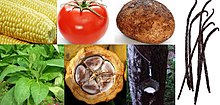Crop

Domesticated plants
A crop is a plant or animal product that can be grown and harvested extensively for profit or subsistence.[1] Crop may refer either to the harvested parts or to the harvest in a more refined state. Most crops are cultivated in agriculture or aquaculture. A crop is usually expanded to include macroscopic fungus (e.g. mushrooms), or alga (algaculture).
Most crops are harvested as food for humans or fodder for livestock. Some crops are gathered from the wild (including intensive gathering, e.g. ginseng).
Important non-food crops include horticulture, floriculture and industrial crops. Horticulture crops include plants used for other crops (e.g. fruit trees). Floriculture crops include bedding plants, houseplants, flowering garden and pot plants, cut cultivated greens, and cut flowers. Industrial crops are produced for clothing (fiber crops), biofuel (energy crops, algae fuel), or medicine (medicinal plants).
Contents
1 Important food crops
2 See also
3 References
4 Further reading
5 External links
Important food crops

Crops drying in a home in Punjab, India.
The importance of a crop varies greatly by region. Globally, the following crops contribute most to human food supply (values of kcal/person/day for 2013 given in parentheses): rice (541 kcal), wheat (527 kcal), sugarcane and other sugar crops (200 kcal), maize (corn) (147 kcal), soybean oil (82 kcal), other vegetables (74 kcal), potatoes (64 kcal), palm oil (52 kcal), cassava (37 kcal), legume pulses (37 kcal), sunflowerseed oil (35 kcal), rape and mustard oil (34 kcal), other fruits, (31 kcal), sorghum (28 kcal), millet (27 kcal), groundnuts (25 kcal), beans (23 kcal), sweet potatoes (22 kcal), bananas (21 kcal), various nuts (16 kcal), soybeans (14 kcal), cottonseed oil (13 kcal), groundnut oil (13 kcal), yams (13 kcal).[2] Note that many of the globally apparently minor crops are regionally very important. For example in Africa, roots & tubers dominate with 421 kcal/person/day, and sorghum and millet contribute 135 kcal and 90 kcal, respectively.[2]
In terms of produced weight, the following crops are the most important ones (global production in thousand metric tonnes):[3]
| Crop | 2000 | 2013 |
|---|---|---|
Sugarcane | 1,256,380 | 1,877,110 |
Maize | 592,479 | 1,016,740 |
Rice | 599,355 | 745,710 |
Wheat | 585,691 | 713,183 |
Potato | 327,600 | 368,096 |
See also
- General topics and economics
- List of most valuable crops and livestock products
- Cash crop
- Catch crop
- Intercropping
- Multiple cropping
- Permanent crop
- Crop yield
- Neglected and underutilized crop
- Sharecropping
- Staple food
Nursery plants- Fruit trees
Floriculture crops- Management practices
- Cover crop
- Crop destruction
- Crop residue
- Crop rotation
- Crop weed
Kharif crops (crops specific to South Asia)- Nurse crop
Rabi crops (crops specific to South Asia)
- Genetic diversity
- Crop diversity
Crop wild relative (CWR)- Seed bank
- Origin
- Neolithic founder crops
- guerrilla gardening
References
^ "Definition of CROP". www.merriam-webster.com. Retrieved June 20, 2017..mw-parser-output cite.citation{font-style:inherit}.mw-parser-output q{quotes:"""""""'""'"}.mw-parser-output code.cs1-code{color:inherit;background:inherit;border:inherit;padding:inherit}.mw-parser-output .cs1-lock-free a{background:url("//upload.wikimedia.org/wikipedia/commons/thumb/6/65/Lock-green.svg/9px-Lock-green.svg.png")no-repeat;background-position:right .1em center}.mw-parser-output .cs1-lock-limited a,.mw-parser-output .cs1-lock-registration a{background:url("//upload.wikimedia.org/wikipedia/commons/thumb/d/d6/Lock-gray-alt-2.svg/9px-Lock-gray-alt-2.svg.png")no-repeat;background-position:right .1em center}.mw-parser-output .cs1-lock-subscription a{background:url("//upload.wikimedia.org/wikipedia/commons/thumb/a/aa/Lock-red-alt-2.svg/9px-Lock-red-alt-2.svg.png")no-repeat;background-position:right .1em center}.mw-parser-output .cs1-subscription,.mw-parser-output .cs1-registration{color:#555}.mw-parser-output .cs1-subscription span,.mw-parser-output .cs1-registration span{border-bottom:1px dotted;cursor:help}.mw-parser-output .cs1-hidden-error{display:none;font-size:100%}.mw-parser-output .cs1-visible-error{font-size:100%}.mw-parser-output .cs1-subscription,.mw-parser-output .cs1-registration,.mw-parser-output .cs1-format{font-size:95%}.mw-parser-output .cs1-kern-left,.mw-parser-output .cs1-kern-wl-left{padding-left:0.2em}.mw-parser-output .cs1-kern-right,.mw-parser-output .cs1-kern-wl-right{padding-right:0.2em}
^ ab Food and Agriculture Organization of the United Nations, Statistics Division (2017). "FAOstats Food Supply - Crops Primary Equivalent".
^ FAO 2015. FAO Statistical Pocketbook 2015,
ISBN 978-92-5-108802-9, p. 28
Further reading
Sleper, David A.; Poehlman, John M. (2006). Breeding Field Crops. Blackwell Publishing. ISBN 9780813824284. Retrieved December 5, 2011.
External links
 Media related to Crops at Wikimedia Commons
Media related to Crops at Wikimedia Commons

